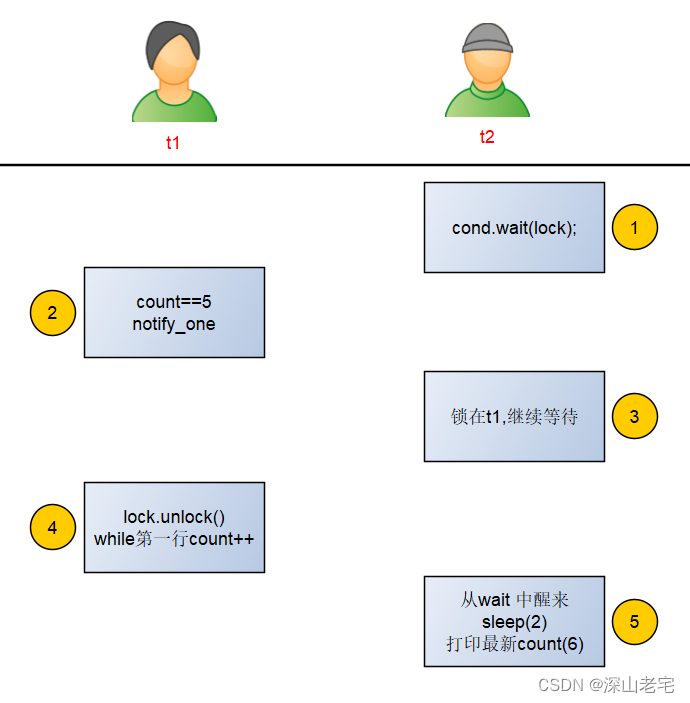Modern C++ 一个例子学习条件变量
发布时间:2024年01月20日
目录
问题程序
今天无意中看到一篇帖子,关于条件变量的,不过仔细看看发现它并达不到原本的目的。
程序如下,读者可以先想想他的本意,以及有没有问题:
#include <iostream>
#include <thread>
#include <condition_variable>
#include <mutex>
#include <unistd.h>
using namespace std;
//全局条件变量
condition_variable cond;
mutex _mutex;
int count = 0;
void fun1(){
while(1)
{
count++;
unique_lock<mutex>lock(_mutex);
if(count%5 == 0)
{
cond.notify_one();
}
else
{
cout<<"this is fun1,count="<<count<<endl;
}
lock.unlock();
sleep(1);
}
}
void fun2()
{
while(1)
{
unique_lock<mutex>lock(_mutex);
cond.wait(lock);
cout<<"this is fun2,count="<<count<<endl;
lock.unlock();
sleep(2);
}
}
int main()
{
thread t1(fun1);
thread t2(fun2);
t1.join();
t2.join();
return 0;
}OK,本意显然是:
- 从1开始打印整数
- 线程t1, 打印非5的倍数
- 线程t2, 打印5的倍数
编译执行,运行的还不错,符合预期,但这都是sleep的功劳。
施魔法让BUG浮出水面
把fun1中的sleep去掉,fun2中的sleep放到cond.wait(lock)后,它BUG的面目就暴露出来了:
void fun1(){
while(1)
{
count++;
unique_lock<mutex>lock(_mutex);
if(count%5 == 0)
{
cond.notify_one();
}
else
{
cout<<"this is fun1,count="<<count<<endl;
}
lock.unlock();
}
}
void fun2()
{
while(1)
{
unique_lock<mutex>lock(_mutex);
cond.wait(lock);
sleep(2);
cout<<"this is fun2,count="<<count<<endl;
lock.unlock();
}
}
[mzhai@lock]$ ./a.out this is fun1,count=1 this is fun1,count=2 this is fun1,count=3 this is fun1,count=4 this is fun2,count=6 this is fun1,count=6 this is fun1,count=7 this is fun1,count=8 this is fun1,count=9 this is fun1,count=11 this is fun1,count=12 this is fun1,count=13 this is fun1,count=14 this is fun1,count=16 this is fun1,count=17 this is fun1,count=18 this is fun1,count=19 this is fun1,count=21多线程结果不能因随机加了几个sleep就不同,加sleep仅仅是模拟线程调度不大一样了。
再回过头来看看代码哪些地方有问题:
- cond.notify_one(); count是5的倍数时,t1会通过notify_one通知t2做事,但并不会阻止t1继续执行。想想一下如果t1执行的很快而t2一直没得到调度,则t1会打印1,2,3,4,6,7,8,9,11...
- cond.wait(lock); 可能会假唤醒,此时t1并没有通知它。
那“this is fun2,count=6” 是怎么回事哪?不应该是5吗?一种可能性是(可以通过GDB调试来模拟):
条件变量注意事项
- 条件变量不擅长单打独斗,一般要和flag变量与锁同时使用。
- notify对方线程并不代表调度让给了对方线程。
修改程序
说了那么多,怎么改哪?
?这是一个典型的你等我我等你的例子,对于这个例子都是一方干完事情另一方才能继续,完全串休化的任务,直接写到一个线程里即可。如果说我为了练习线程同步技巧非要整两个线程,那也行,condition_variable官方文档上就有一个例子实现了main线程等待worker_thread完成任务:
#include <condition_variable>
#include <iostream>
#include <mutex>
#include <string>
#include <thread>
std::mutex m;
std::condition_variable cv;
std::string data;
bool ready = false;
bool processed = false;
void worker_thread()
{
// Wait until main() sends data
std::unique_lock lk(m);
cv.wait(lk, []{ return ready; });
// after the wait, we own the lock.
std::cout << "Worker thread is processing data\n";
data += " after processing";
// Send data back to main()
processed = true;
std::cout << "Worker thread signals data processing completed\n";
// Manual unlocking is done before notifying, to avoid waking up
// the waiting thread only to block again (see notify_one for details)
lk.unlock();
cv.notify_one();
}
int main()
{
std::thread worker(worker_thread);
data = "Example data";
// send data to the worker thread
{
std::lock_guard lk(m);
ready = true;
std::cout << "main() signals data ready for processing\n";
}
cv.notify_one();
// wait for the worker
{
std::unique_lock lk(m);
cv.wait(lk, []{ return processed; });
}
std::cout << "Back in main(), data = " << data << '\n';
worker.join();
}我们依样画葫芦:
#include <iostream>
#include <thread>
#include <condition_variable>
#include <mutex>
#include <unistd.h>
using namespace std;
//全局条件变量
condition_variable cond;
mutex _mutex;
bool ready = false;
bool processed = false;
int count = 0;
void fun1(){
while(1)
{
count++;
unique_lock<mutex> lock1(_mutex);
if(count%5 == 0)
{
ready = true;
processed = false;
lock1.unlock();
cond.notify_one();
lock1.lock();
cond.wait(lock1, []{ return processed; });
}
else
{
cout<<"this is fun1,count="<<count<<endl;
}
lock1.unlock();
}
}
void fun2()
{
while(1)
{
unique_lock<mutex> lock1(_mutex);
cond.wait(lock1, []{ return ready; });
cout<<"this is fun2,count="<<count<<endl;
processed = true;
ready = false;
lock1.unlock();
cond.notify_one();
}
}
int main()
{
thread t1(fun1);
thread t2(fun2);
t1.join();
t2.join();
return 0;
}
结果符合预期,感兴趣的读者可以到处插入sleep测试一下。
啰嗦几句多线程程序的测试
多线程程序架构设计很重要,因为它很难测试,很难穷尽负面测试用例。几种可行的测试办法:
- 随机加sleep。需要改程序。参考上面。
- GDB调试。模拟和正常运行不同的调度策略。参考《GDB调试技巧实战--多线程&弱鸡条件变量-CSDN博客》
- strace、bpftrace、bcc把快速运行的程序降慢。目的是降低一个线程的速度,另一个保持原来的速度或者也降低。原来两者都是100迈前进,那一个100另一个50会不会出问题?或者10 20哪?组合就很多了。
文章来源:https://blog.csdn.net/zhaiminlove/article/details/135707091
本文来自互联网用户投稿,该文观点仅代表作者本人,不代表本站立场。本站仅提供信息存储空间服务,不拥有所有权,不承担相关法律责任。 如若内容造成侵权/违法违规/事实不符,请联系我的编程经验分享网邮箱:chenni525@qq.com进行投诉反馈,一经查实,立即删除!
本文来自互联网用户投稿,该文观点仅代表作者本人,不代表本站立场。本站仅提供信息存储空间服务,不拥有所有权,不承担相关法律责任。 如若内容造成侵权/违法违规/事实不符,请联系我的编程经验分享网邮箱:chenni525@qq.com进行投诉反馈,一经查实,立即删除!
最新文章
- Python教程
- 深入理解 MySQL 中的 HAVING 关键字和聚合函数
- Qt之QChar编码(1)
- MyBatis入门基础篇
- 用Python脚本实现FFmpeg批量转换
- C语言概述习题
- 7个常用的原型设计工具,产品经理看过来!
- 【Threejs】代码+图文带你快速上手
- 精细化管理如何助力企业效率起飞?6 大行业真实案例揭秘
- 360集团:将以鸿蒙系统为核心,进行旗下应用的全面升级和开发
- ffmpeg 解码文件时的时间戳问题
- YOLOv8训练DOTAv2数据集(官网代码/数据集转换/2024.1.2)
- 幂法和反幂法(C++)
- UF_UI_select_with_single_dialog()通过单选对话框选择单个对象。对象可以通过光标或输入名称进行选择。对象被突显出来。
- 【图像拼接】论文精读:Fast and robust seam estimation to seamless image stitching(FARSE)
